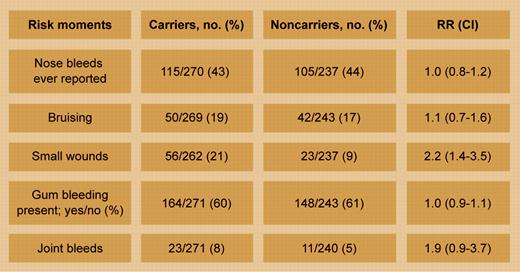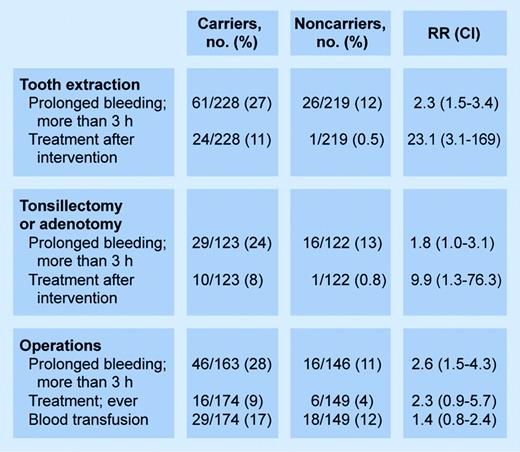Comment on Plug et al, page 52
Historically, hemophilia carriers have not been considered to be at risk for bleeding. This paper challenges the convention that these patients will be hemostatically normal if their factor levels exceed 40%.
In this issue of Blood, Plug and colleagues report the largest survey of hemophilia carriers, either obligate or de novo; compare their factor levels to noncarriers; and demonstrate that, even at levels of coagulation factors considered hemostatic, these patients bleed substantially more than expected. Historically, hemophilia carriers were identified as either obligate, daughters of hemophiliacs, or de novo mutations, which are now more easily identified by genetic testing. Extrapolating from our knowledge of hemophilia, levels of factor greater than 25% to 30% have given clinicians confidence that hemostasis is essentially normal.
Using questionnaires, 274 carriers and 245 noncarriers were analyzed. Information on bleeding patterns, use of oral contraception, DNA analysis, and factor levels were available.
Risk of bleeding of carriers versus noncarriers spontaneously or after trauma. See the complete table in the article beginning onpage 52. Illustration by Frank Forney.
Risk of bleeding of carriers versus noncarriers spontaneously or after trauma. See the complete table in the article beginning onpage 52. Illustration by Frank Forney.
The major contribution of this paper is the demonstration that carriers with factor levels between 40% and 60% had an increased risk of bleeding compared with controls. As predicted, the risk increases as the levels decrease. These findings, as stated in the paper, challenge the International Society on Thrombosis and Haemostasis (ISTH) definition of hemophilia, which states that the disease is defined as present in persons with factor levels less than 40%.1 The importance of measuring the factor level of carriers is highlighted by these data not only to better understand the natural history of carriers, but to optimize perioperative and postoperative management of these patients.
The authors carefully and correctly advise the readership of the limitations of the study. There may be bias by selection of who responded and how de novo carriers were detected (ie, because of bleeding symptoms). Obligate carriers who are knowledgeable about hemophilia bleeding from family members were dealt with by including carriers and non-carriers with similar environments. Factor levels taken from medical records may not always reflect the lowest level that these patients may have at a different time.
Risk of bleeding of carriers versus noncarriers after medical interventions. See the complete table in the article beginning onpage 52. Illustration by Frank Forney.
Risk of bleeding of carriers versus noncarriers after medical interventions. See the complete table in the article beginning onpage 52. Illustration by Frank Forney.
There are several areas either not evaluated or not discussed in this paper. For those patients with spontaneous or interventral bleeding, there was no discussion of the type of treatment these patients were offered to achieve hemostasis. Did these patients receive desmopressin? Were some given factor replacement? Was oral contraception initiated because of bleeding to control menorrhagia or to increase factor levels, or as long-term management? Mild hemophilia patients who are exposed to factor concentrates may develop factor inhibitors. No mention was made if any of these women had ever developed an inhibitor and/or if they had ever received factor VIII replacement. These issues would have enhanced the impact of this paper.
This large series of women studied in the Netherlands teaches us a great lesson. Carriers, per se, need to be evaluated, assayed and counseled, prepared to deal with bleeding, and appropriately managed for surgical intervention. ▪



This feature is available to Subscribers Only
Sign In or Create an Account Close Modal